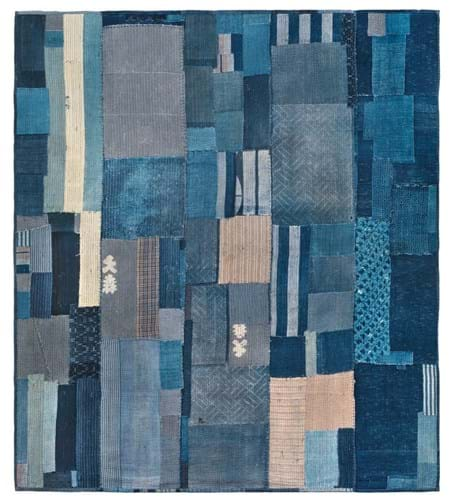Boro textiles were stitched together by the poor in rural communities of 18th and early 19th century northern Japan. Despite their humble origins, these indigo patchworks remain appealing for collectors today thanks to their abstract, almost contemporary look.
Twelve from the collection of independent tribal art dealer Gordon Reece are featured in an exhibition at the gallery 8 Holland Street.
The show starts at 8 Holland Street’s new Bath premises, which opened in June.
It runs from August 15-September 14 before travelling to the firm’s site in Kensington, London, from September 19-October 19.
Personal touch
Pieced together with homespun bast (or plant) fibre, boro were often reinforced using traditional sashiko stitching, which lent a personal touch to a bedcover or clothing made from salvaged pieces of fabric at a time when cotton was a luxury. The textiles were passed down and added to by successive generations.
Few survive, however. Following the Meiji Period and a general rise in living standards across Japan, the textiles were considered testament to an embarrassing history of former poverty.
Many were discarded and the preservation of boro is down in large part to 20th century folklorist Chuzaburo Tanaka, who amassed more than 20,000 examples.
“Gordon has continued to challenge the solely Western art-historical view
Of his collection, 786 are designated as important Tangible Cultural Properties and 1500 are on display at Amuse Museum in Tokyo.
For audiences today, the technique has a unique aesthetic and may also appeal as an early representation of recycling (even if the impulse to make the textiles came from a more immediate drive for survival).
The Reece group now offered by 8 Holland Street was last publicly displayed in the UK at the exhibition Boro – Threads of Life in Somerset House, London, in 2014. Of the 12 on show, eight are from the private collection of Japanese vintage dealer Tadashi Morita, who was also instrumental in reclaiming this folk tradition.
The show also features specially created contemporary pieces made in response to the traditional textiles by artists Catarina Riccabona and Abigail Booth (of Forest + Found), both of whom address issues of sustainability in their output.
Works in the show range from around £15,000-25,000.
Dealer Reece, a specialist in Asian and African artefacts for 38 years, has held exhibitions in both London and North Yorkshire during a 38-year career.
“Gordon is a maverick and his vision is pioneering,” says 8 Holland Street’s Rowena Morgan-Cox. “He has continued to challenge the solely Western art-historical view.”
The gallery specialises in European art and design from c.1900 onwards as well as European vintage furniture, studio pottery and textiles.
The new gallery covers three floors and offers antique and modern furniture with a greater emphasis on smaller products and homeware, including textiles and ceramics.
















